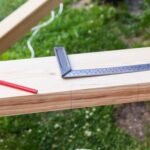What is a jointer woodworking? Woodworking is the art and craft of creating objects from wood, and it has been practiced for centuries. In woodworking, precision and accuracy are crucial, and this is where a jointer comes into play.
A jointer is a vital tool that helps woodworkers create flat surfaces, straight edges, and seamless connections in their projects. This article will delve into the world of woodworking and explore the history, types, functionality, and importance of jointers in this craft.
Woodworking has a rich history, with jointers playing a significant role in shaping its evolution. From traditional hand tools to modern stationary machines, jointers have undergone various innovations and developments over time. Understanding the history of jointers provides valuable insights into their importance and impact on woodworking practices today.
There are several types of jointers available in woodworking, each with its own unique features and purposes. Whether it’s a benchtop jointer for small-scale projects or a stationary jointer for larger pieces of wood, woodworkers have a range of options to choose from when it comes to selecting the right tool for their needs. It’s important to understand the differences between these types of jointers to make informed decisions in the workshop.
History of Jointers
The history of jointers in woodworking dates back centuries, with the earliest forms of jointing tools being simple hand planes used to flatten and smooth wood surfaces. As woodworking evolved and advanced over time, so did the tools used in the craft. One significant development in the history of jointers was the invention of the modern jointer machine in the 19th century, which revolutionized woodworking processes.
The early jointer machines were manually operated and required a great deal of physical labor to operate. However, technological advancements in the 20th century led to the creation of electric-powered jointers, making them more efficient and easier to use. This innovation allowed woodworkers to achieve greater precision and accuracy in their projects, ultimately shaping the way woodworking is practiced today.
In recent years, advancements in technology have led to further improvements in jointer design and functionality. Modern jointers now come equipped with features such as spiral cutterheads, adjustable tables, and digital control systems, allowing woodworkers to achieve even higher levels of precision and control. The history of jointers demonstrates how this essential tool has continued to evolve and adapt to meet the changing needs of woodworkers, making it an indispensable part of any woodworking shop.
Types of Jointers
A jointer is an essential tool in the woodworking process, as it helps create flat surfaces and smooth edges on wooden boards. There are several types of jointers available, each with specific functions and features that cater to different woodworking needs. Understanding the different types of jointers can help woodworkers choose the best option for their projects.
One common type of jointer is the benchtop jointer, which is a compact and portable tool designed for smaller woodworking tasks. It is ideal for hobbyists and DIY enthusiasts who may have limited space in their workshops. On the other hand, hand jointers are handheld tools that allow for more precision and control when smoothing and flattening wood surfaces. They are commonly used for fine woodworking and intricate detailing.
For larger woodworking projects, stationary jointers are often preferred due to their stability and power. Stationary jointers come in various sizes, with some models featuring long beds to accommodate longer workpieces. These jointers are suitable for professional woodshops and industrial settings where heavy-duty equipment is needed to handle large volumes of work.
In summary, understanding the differences between benchtop, hand, and stationary jointers can help woodworkers make informed decisions when selecting the right tool for their projects. Each type of jointer offers unique advantages and capabilities that cater to specific woodworking requirements.
| Type of Jointer | Features |
|---|---|
| Benchtop Jointer | Compact, portable, ideal for smaller tasks |
| Hand Jointer | Handheld, allows precision and control |
| Stationary Jointer | Stable, powerful, suitable for larger projects |
How Does a Jointer Work
A jointer is an essential tool in woodworking that is used to create flat and smooth surfaces on pieces of wood. This process is crucial for ensuring that the wood can be accurately connected and joined together to create high-quality furniture, cabinetry, or other wooden structures. Understanding how a jointer works and its mechanics is key to using this tool effectively in woodworking projects.
The Functionality of a Jointer
A jointer consists of a flat surface with a cutting blade positioned at just the right height to shave off thin layers of wood from the surface of a piece of lumber. As the wood passes over the blade, it is flattened and smoothed, resulting in a uniform and even surface. This process is essential for preparing wood for further shaping, joining, or finishing.
How It Flattens and Smoothens Wood Surfaces
The key function of a jointer in woodworking is to eliminate any imperfections or roughness from the surface of the wood. By removing small amounts of material with each pass, the jointer gradually flattens the board and creates an even, polished surface. This allows for precise connections between pieces of wood when constructing furniture or other wooden items.
Mechanics of Using a Jointer
When operating a jointer, it’s important to feed the wood through steadily and at a consistent pace to ensure an even finish. Proper adjustment of the infeed table and outfeed table alignment is crucial to achieve optimal results. Additionally, understanding how to position the grain orientation on the board can impact how well the jointer operates, as cutting against grain can result in tear-out or splintering on the wood surface.
Understanding these fundamental principles of how a jointer works is essential for any woodworking enthusiast or professional looking to achieve precision and quality in their projects. Learning these mechanics will enable individuals to use jointers effectively while also maintaining safety during operation.
Importance of Jointers in Woodworking
A jointer is an essential tool in the woodworking process, playing a crucial role in creating precision, accuracy, and seamless connections in various woodworking projects. Whether you’re a professional woodworker or a hobbyist, understanding the importance of jointers can significantly impact the quality of your craftsmanship. Here are some key reasons why jointers are indispensable in woodworking:
- Flattening surfaces: Jointers are used to flatten and straighten the edges and faces of boards, ensuring that they are uniform and without imperfections. This is particularly important when working on projects that require smooth and even surfaces, such as tabletops, cabinets, and doors.
- Achieving precise edges: By using a jointer to create perfectly flat edges, woodworkers can achieve precise joinery for strong and seamless connections between wooden pieces. This is essential for constructing furniture, frames, and other woodworking structures.
- Improving overall quality: The use of a jointer results in improved overall quality of woodworking projects by eliminating warping, twisting, or unevenness in the wood. This not only enhances the aesthetic appeal but also ensures structural integrity and durability.
Understanding the vital role that jointers play in achieving high-quality woodworking results can help woodworkers appreciate the significance of this tool in their craft. With a combination of precision, accuracy, and attention to detail provided by a jointer, woodworkers can elevate their projects to new levels of excellence.
It’s important to note that while a jointer is invaluable in creating precise connections and smooth surfaces during woodworking projects, it must be used with proper technique and safety measures. Therefore, familiarizing oneself with best practices for using a jointer effectively is essential for achieving optimal results in woodworking endeavors.
Tips for Using a Jointer
When using a jointer woodworking, it is essential to have a clear understanding of the best practices for using this tool effectively and safely. Whether you are a seasoned woodworker or just starting out, these tips will help you make the most of your jointer and achieve professional-looking results in your projects.
Proper Setup and Alignment
Before using a jointer, it is crucial to ensure that the machine is properly set up and aligned. This includes adjusting the infeed and outfeed tables to the correct height and parallel alignment with the cutter head. Additionally, making sure that the fence is square to the tables will result in accurate jointing of your wood pieces. Taking the time to check and adjust these elements will contribute to the overall precision and quality of your woodworking project.
Understanding Grain Direction
One important tip when using a jointer is to pay attention to the direction of the wood grain. It is recommended to feed wood into the jointer against the grain, as this can result in tear-out and an uneven surface. By understanding how grain direction affects the cutting action of the jointer blades, you can achieve smoother cuts and reduce any potential damage to your wood pieces.
Using Push Blocks and Safety Gear
For safety reasons, it is crucial to use push blocks or push pads when feeding wood through a jointer. This helps keep your hands at a safe distance from the rotating cutter head while still providing adequate pressure on the workpiece. Additionally, wearing appropriate safety gear such as safety glasses and hearing protection is essential when operating power tools like a jointer. Prioritizing safety measures will ensure a smooth and incident-free woodworking experience when using a jointer.
By following these tips for using a jointer effectively, you can enhance your woodworking skills, create seamless connections between wood pieces, and produce high-quality finished products with ease and precision. Understanding proper setup, grain direction, and safety precautions will contribute to successful outcomes in various woodworking projects involving a jointer.
Common Mistakes to Avoid
Using a jointer in woodworking can significantly enhance the quality and precision of your projects. However, it is essential to be aware of common mistakes that woodworkers often make when operating a jointer. By understanding these errors and learning how to avoid them, you can ensure that your woodworking endeavors yield professional results.
One common mistake when using a jointer is failing to set the depth of cut correctly. This can result in uneven surfaces and inconsistencies in the thickness of the wood. To prevent this, always take the time to adjust the depth of cut on your jointer according to the specific requirements of your project. Check for any snipe at the beginning and end of your workpieces, and make necessary adjustments to minimize or eliminate it.
Another frequent error is neglecting to properly support and guide the wood as it passes through the jointer. Without adequate support, there is a risk of experiencing snipe, gouges, or uneven cuts. To avoid this issue, use auxiliary support tools such as roller stands or infeed/outfeed tables to ensure smooth and stable movement of the wood across the jointer.
It is also important to pay attention to grain direction when jointing wood. Ignoring grain direction can lead to tearout, which creates an unsightly surface on your workpiece. Always assess the grain pattern of the wood before running it through the jointer, and adjust your cutting technique accordingly to achieve clean and smooth results.
| Mistake | Prevention |
|---|---|
| Failing to set depth of cut correctly | Always adjusting depths according to project needs |
| Neglecting proper support for wood | Using auxiliary support tools for stability |
| Ignoring grain direction | Evaluating grain pattern before setting up cuts |
Conclusion
In conclusion, a jointer woodworking is an essential tool for any woodworking enthusiast, whether they are a novice or an experienced craftsman. Throughout history, jointers have evolved and advanced, offering various types such as benchtop jointers, hand jointers, and stationary jointers to cater to the diverse needs of woodworkers. The functionality and mechanics of a jointer are designed to flatten and smooth wood surfaces with precision and accuracy, making it a crucial component in creating seamless connections in woodworking projects.
It is important to recognize the significance of jointers in woodworking, as they play a vital role in achieving the desired results in any project. From creating seamless joints to ensuring precision and accuracy, a jointer is indispensable for anyone working with wood.
However, it is also important to note that using a jointer effectively requires knowledge and skill. Woodworkers should seek out practical advice and techniques for using this tool safely and efficiently in order to avoid common mistakes that can compromise the success of their projects.
Ultimately, understanding what is a jointer woodworking and its importance offers valuable insight into the world of woodworking tools and techniques. By exploring the history, functionality, and practical tips for using a jointer effectively, woodworkers can enhance their skills and craftsmanship. Aspiring woodworkers should continue to further explore the diverse range of tools available in woodworking, including jointers, to expand their knowledge and capabilities in this timeless craft.
Frequently Asked Questions
What Is Difference Between Jointer and Planer?
A jointer and planer are both tools used in woodworking, but they serve different purposes. A jointer is primarily used to create a flat surface on the face or edge of a board, while a planer is used to make the opposite face parallel and to adjust the thickness of the board.
What Is the Difference Between a Shaper and a Jointer?
The main difference between a shaper and a jointer lies in their functions. A shaper is used to cut profiles into wood, such as creating edges or moldings, while a jointer is used specifically for flattening and squaring the edges of a board.
What Is the Difference Between a Jointer and a Power Planer?
When comparing a jointer and a power planer, the key difference lies in how they are used. A jointer is designed to flatten and straighten the edge of a board, while a power planer is best suited for adjusting the thickness of the board with uniform depth across its surface.

Hi everyone! I’m a woodworker and blogger, and this is my woodworking blog. In my blog, I share tips and tricks for woodworkers of all skill levels, as well as project ideas that you can try yourself.





